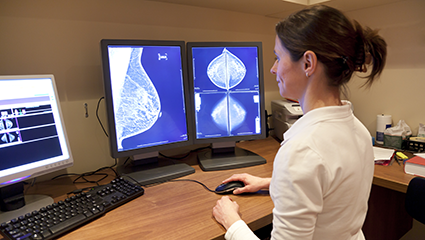Click here to read our 2025 code changes update article.
The big news in Current Procedural Terminology[i] (CPT)® revisions for 2021 is the overhaul of the Evaluation and Management (E&M) section, reducing documentation requirements, and introducing new rules for determining the level of coding. These changes will affect interventional radiologists and radiation oncologists more than they will the day-to-day work of diagnostic radiologists. First, we will review the other non-E&M code changes affecting diagnostic and interventional radiology for 2021.
Categories:
radiology coding,
interventional radiology,
IR coding,
CPT codes,
radiology,
diagnostic radiology
Click here to read our 2025 code changes update article.
With the new year comes the annual revision of Current Procedural Terminology[i] (CPT)® coding that practices have to be aware of. For diagnostic radiology, the changes for 2020 are relatively few and they are concentrated in the areas of abdominal and gastrointestinal plain films, nuclear medicine procedures for tumor localization, and myocardial PET imaging. The changes to interventional radiology coding are likewise quite limited and involve pericardial and spinal puncture procedures.
Categories:
radiology coding,
IR coding,
CPT codes
Our own Sandy Coffta, Vice President of Client Services, spoke with Aunt Minnie’s Brian Casey at the 2019 RSNA Annual Meeting in Chicago. In the interview posted on auntminnie.com, Sandy mentioned some of the highlights that practices should be concerned about in the coming year.
Categories:
radiology reimbursement,
radiology billing,
radiology documentation,
radiology coding,
radiology
The 2020 annual update to the ICD-10-CM[i] system used in medical insurance claim billing became effective on October 1, 2019. Twenty-one (21) codes were deleted, thirty (30) codes were revised and 273 new codes were added. The good news for radiologists is that relatively few of these changes will affect your work.
Categories:
radiology coding,
icd-10
Read our 2021 IR billing & coding article
A radiology practice that performs interventional procedures will want to be up to date on the use of documentation and coding techniques for Evaluation and Management (E&M) services. These CPT® codes in the 99xxx range are less commonly utilized in radiology practices. Identifying circumstances where E&M services are billable, and then properly documenting and coding for them, will require a collaborative effort between the interventional radiologist (IR) and his or her coding team.
Categories:
radiology billing,
radiology coding,
interventional radiology,
radiology
The Medicare Physician Fee Schedule (MPFS) for 2017 contained some revisions to the coding and reimbursement for moderate sedation that will potentially impact radiology practices. Previously, moderate sedation was not separately reimbursed for many of the procedures listed in Appendix G of the CPT®[i] codebook. Sedation was bundled with the basic procedure, but now it will be reimbursed in addition to the basic procedure. There are important guidelines and documentation that must be met in order to use these codes, and radiologists interested in maximizing their reimbursements should review their reporting to be sure it supports proper coding under the new rules.

Categories:
radiology documentation,
radiology coding
Medicare publishes its rules and requirements for the coding and billing of medical procedures to obtain reimbursement under its programs, but many commercial insurers are not as transparent about their own requirements. This leaves medical billing professionals in the dark when there are new procedure codes or changes to existing coding in the American Medical Association’s CPT® code set or by federal regulation. Such is the case with mammography coding for 2017. Below we have summarized the key coding considerations for radiology practices billing mammography services this year. (Click here to read our complete article on the 2017 coding changes impacting diagnostic and intervential radiology.)
Categories:
radiology reimbursement,
radiology coding,
breast imaging
Click here to read our 2024 code changes update article.
The annual cycle of revising codes in the Current Procedural Terminology (CPT)® has been completed with the issuance of the Medicare Physician Fee Schedule (MPFS) Final Rule for 2017. For diagnostic radiology, the changes this year are in mammography bundling, ultrasound screening for abdominal aortic aneurysm, and fluoroscopic guidance. Interventional Radiology (IR) will also be subject to bundling and other rearranging of codes for certain procedures. Finally, there are new codes that have been created to describe procedures previously unlisted, which generally will improve reimbursement for those procedures, and codes deleted from use, which will return the affected procedures to the ‘unlisted’ category.
Categories:
radiology reimbursement,
radiology coding,
interventional radiology,
IR coding,
CPT codes
Our first article in this series provided a list of questions to ask when evaluating a professional services Revenue Cycle Management (RCM) vendor for your radiology practice. If your current RCM vendor cannot answer all of them positively, it’s time to look for a new vendor. With a large number of RCM companies available in the market, how should you decide which one to choose?
Categories:
radiology reimbursement,
radiology billing,
radiology coding
When a major hospital-based radiology practice realized that their outpatient volume had dropped suddenly, their Revenue Cycle Management (RCM) company stepped up to quickly diagnose the problem. Using their analytic database, they produced a focused referring doctor report that revealed significant outpatient service volume declines concentrated among a handful of providers, one of which had decreased by 60%. It’s this kind of responsiveness that sets a true RCM partner apart from the average vendor.
Categories:
radiology billing,
radiology coding














